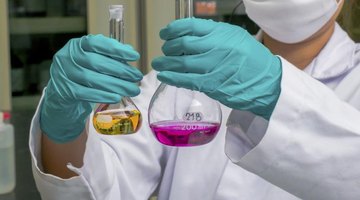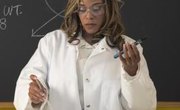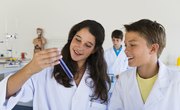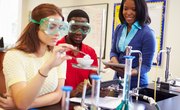As a high school teacher, it’s your job to involve students in class. You want students to learn academic concepts as well as to be able to apply what they learn in their everyday lives. Chemistry is a part of many things in life, such as running a car or baking food, so it’s relatively simple to find real-life applications. Teach chemistry via a series of lectures, demonstrations and laboratory exercises to maintain your students’ interests and help them reach their academic goals.
Important Topics
Before you begin teaching a chemistry class, you must prepare a curriculum that fulfills academic requirements and inspires a longing to learn more about science. The American Chemical Society outlines four “big ideas in chemistry” the society believes teachers should address in a high school curriculum: conservation of matter and energy, behavior and properties of matter, particulate nature of matter and the equilibrium of driving forces. These big ideas include topics such as that atoms are rearranged in chemical reactions rather than destroyed; atoms form bonds; atoms and molecules have particular structures; and chemical reactions can be classified into specific types. Take a look at your syllabus to ensure these big ideas are covered in your curriculum. You should teach this curriculum via lectures, demonstrations, discussions and hands-on activities.
Ways to Start Class
Classes of any kind begin with engagement. No one method is best for everyone, but select an activity that suits you and your teaching style. You can begin class with a chemistry joke and if the students don’t get it, you can always follow up with, “Told a chemistry joke. There was no reaction.” If students are still confused, you can launch into a discussion about chemical reactions. You could begin class with a question that leads to discussion. For example, ask how pollutants become dissolved in water to lead into a discussion about green chemistry. You could ask about current events and how these events might relate to a chemistry topic. Another option is a demonstration. Put up a clear safety shield and throw a small piece of sodium in a bucket of water and watch it explode. This demonstration may have shocked your students, but they paid attention.
Student Engagement
After you have your students’ attention, you need to maintain it. Before you start your lecture, ask your students a question – particularly a question related to their lives such as “What happens to plastic bottles after you recycle them?” These questions encourage students to think more deeply about their everyday experiences, according to the ACS. Questions such as these might also help you pinpoint misconceptions that students have about a topic. Science is centered on problem solving, so demonstrate how you would solve real-life problems, encouraging students to do the same. Teach vocabulary terms and use visual aids like Lewis dot structures or molecule model kits to aid learning. The ACS also suggests that you have students keep a journal to write about the problems they solved or which real-world applications they learned about in class.
Laboratory Experience
A huge component of high school chemistry is the laboratory experience. Lab time encourages high school students to work as a team and puts their problem-solving strategies discussed in class into practice. Via a hands-on activity, these lab experiences should solidify concepts and principles they learned in lectures. Divide lab time into three components: pre-lab, procedure, and post-lab. The pre-lab includes discussion about the topic as well as your student’s hypotheses about what will happen. During the procedure, students carry out experiments, where they also observe and record data. In the post-lab, students interpret data and compare results. Before you begin any experiments, however, give high school students a solid lecture about safety. Ensure that the students wear appropriate clothing, use safety gloves and goggles, and teach students where emergency wash stations are located. As chemistry labs require the use of chemicals, teach the students about warning labels and how to handle chemicals that are flammable, toxic or corrosive.
Related Articles
References
Writer Bio
Cara Batema is a musician, teacher and writer who specializes in early childhood, special needs and psychology. Since 2010, Batema has been an active writer in the fields of education, parenting, science and health. She holds a bachelor's degree in music therapy and creative writing.











